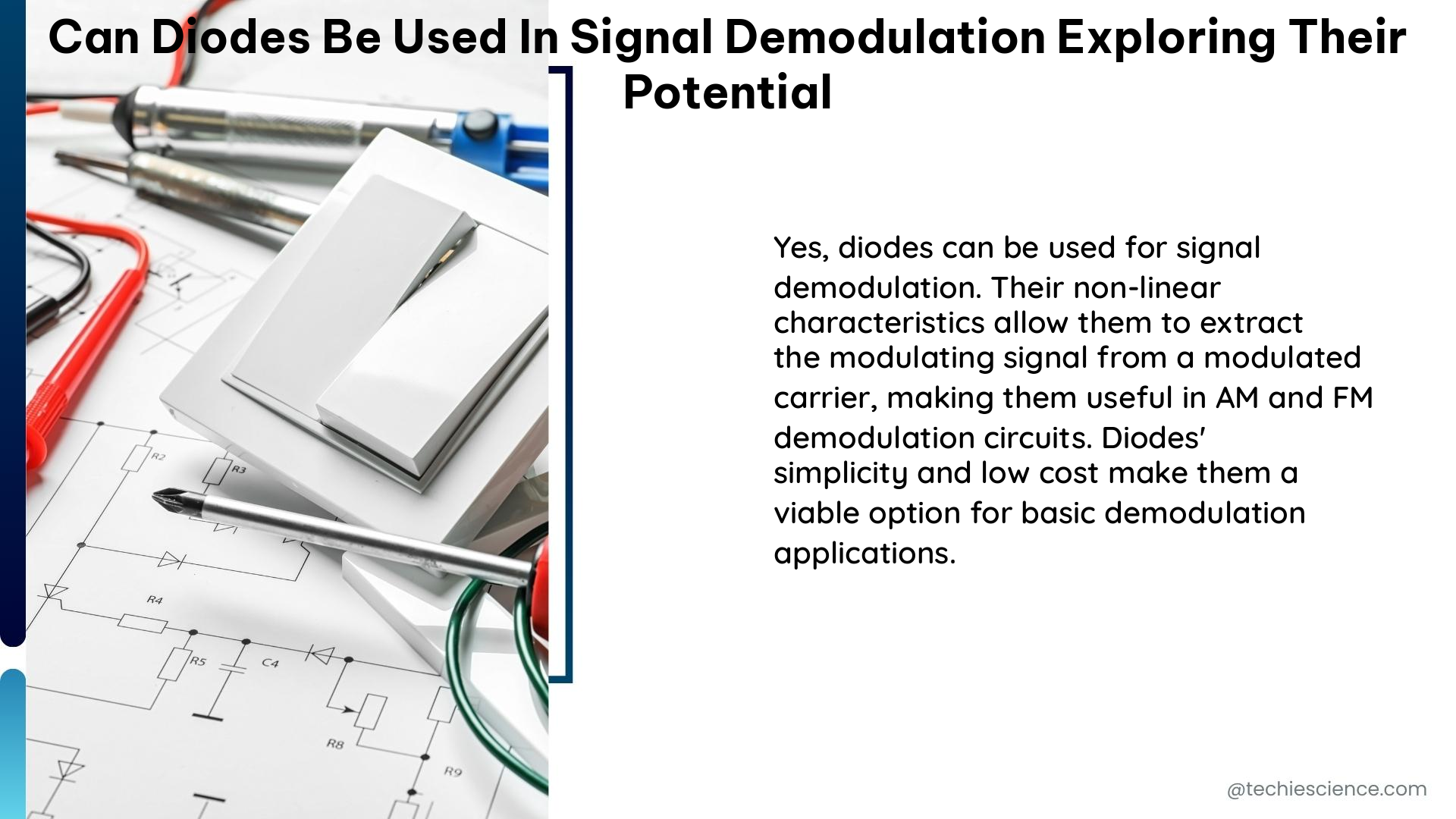Diodes, particularly signal diodes, are commonly used in signal demodulation due to their low junction capacitance and ability to rectify signals. In the context of amplitude modulation (AM) demodulation, diodes are used to rectify the AM signal, which is then filtered to obtain the original audio signal.
Understanding Diode-based Demodulation Circuits
The diode-based demodulation circuit typically consists of a diode, a load resistor, and a capacitor. The diode rectifies the AM signal, the load resistor provides a path for the rectified current, and the capacitor filters out the high-frequency components, leaving behind the low-frequency audio signal.
Diode Selection: Crucial for Demodulation Performance
The choice of diode is crucial in demodulation circuits. Signal diodes, such as the OA79, are preferred over rectifier diodes due to their lower junction capacitance. A lower junction capacitance ensures that the diode does not form an undesirable leakage path across the diode, which could affect the quality of the demodulated signal.
Typical junction capacitance values for signal diodes range from 0.5 pF to 5 pF, while rectifier diodes can have junction capacitances in the range of 10 pF to 50 pF. This difference in junction capacitance can have a significant impact on the performance of the demodulation circuit.
Component Value Selection: Balancing Frequency Considerations
In terms of component values, the choice of resistor and capacitor values depends on the frequency of the modulated signal and the desired cutoff frequency of the low-pass filter. For instance, in a diode-RC demodulator designed for a modulated signal with a carrier frequency of 1 MHz and a modulation frequency of 10 kHz, a capacitor value of 0.1 µF and a resistor value of 500 ohms would be suitable.
The capacitor value should be chosen to provide sufficient filtering of the high-frequency carrier signal, while the resistor value should be selected to ensure that the time constant (RC) of the low-pass filter is appropriate for the modulation frequency. Typically, the time constant should be much larger than the period of the modulation frequency to ensure effective filtering.
Advantages of Diode-based Demodulation

Diode-based demodulation circuits offer several advantages:
- Simplicity: The circuit is relatively simple, consisting of just a diode, a resistor, and a capacitor, making it easy to implement and maintain.
- Low Cost: Diodes are inexpensive components, making the overall demodulation circuit cost-effective.
- Reliability: Diodes are generally robust and reliable components, contributing to the overall reliability of the demodulation circuit.
- Efficiency: Diode-based demodulation circuits are efficient in converting the modulated signal into the original audio signal, with minimal power loss.
Limitations and Considerations
While diode-based demodulation circuits are widely used, there are some limitations and considerations to keep in mind:
- Nonlinearity: Diodes exhibit a nonlinear voltage-current characteristic, which can introduce distortion in the demodulated signal, particularly at higher modulation depths.
- Bandwidth Limitations: The bandwidth of the demodulation circuit is limited by the cutoff frequency of the low-pass filter, which is determined by the resistor and capacitor values.
- Temperature Sensitivity: The performance of diodes can be affected by temperature variations, which can impact the demodulation quality.
- Noise Sensitivity: Diodes can be susceptible to noise, which can degrade the signal-to-noise ratio of the demodulated signal.
Advanced Demodulation Techniques
While diode-based demodulation is a common and straightforward approach, there are more advanced demodulation techniques that can offer improved performance:
- Synchronous Demodulation: Synchronous demodulation uses a phase-locked loop (PLL) to generate a local oscillator signal that is synchronized with the carrier frequency of the modulated signal. This technique can provide better noise rejection and improved demodulation quality.
- Envelope Demodulation: Envelope demodulation involves detecting the envelope of the modulated signal, which can be more robust to noise and distortion compared to diode-based demodulation.
- Digital Demodulation: With the advent of digital signal processing (DSP) techniques, digital demodulation algorithms can be implemented using microcontrollers or dedicated DSP chips. These digital approaches can offer enhanced performance, flexibility, and programmability.
Conclusion
Diodes, particularly signal diodes, are widely used in signal demodulation due to their low junction capacitance and rectification properties. The choice of diode and component values is critical in ensuring the quality of the demodulated signal. While diode-based demodulation circuits are simple and cost-effective, there are more advanced demodulation techniques that can offer improved performance in certain applications.
References
- Diode Demodulation for AM
- How does a rectifier demodulate radio information, and why does its capacitance matter?
- Designing a Diode-RC AM Demodulator: Component Values for 1MHz Fc and 10kHz FM
- What is Demodulation?

The lambdageeks.com Core SME Team is a group of experienced subject matter experts from diverse scientific and technical fields including Physics, Chemistry, Technology,Electronics & Electrical Engineering, Automotive, Mechanical Engineering. Our team collaborates to create high-quality, well-researched articles on a wide range of science and technology topics for the lambdageeks.com website.
All Our Senior SME are having more than 7 Years of experience in the respective fields . They are either Working Industry Professionals or assocaited With different Universities. Refer Our Authors Page to get to know About our Core SMEs.